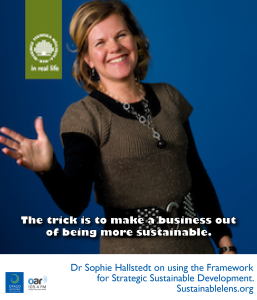The trick is to make a business out of being more sustainable.
Dr Sophie Hallstedt is a researcher and lecturer at in the Department of Strategic Sustainable Development at
Blekinge Institute of Technology. Her research interest is sustainable product development and the question of how a strategic sustainability perspective can be integrated and implemented into product innovation process with focus on the early phases.
This conversation is one of a series of four recorded at Blekinge Institute of Technology Department of Strategic Sustainable Development in September 2014.
Talking points
Strategic sustainable development means you you take a strategic approach to the success ladder.
Supporting companies to consider sustainability as part of everything they do.
If you talk to individuals in an organisation, many are concerned about the unsustainable society that we live in, and they want to contribute…but as part of a bigger organisation it’s not always so easy to do that – to put that on the agenda when there are other issues that are putting pressure on the company.
You need to have a long term perspective. If you only look at today, you might have one choice, but if you look 10-15 years ahead, what would be the best alternative if you could then choose for today. It may be best to invest in the thing that is more expensive today but will in the long term be more beneficial.
We are developing support for including the long term in decision making. This is tricky because you don’t know what is going to happen. So we use scenarios.
We have a tool for visualising scenarios.
There’s a danger of reducing to economic terms if you do it too soon. You need to keep it as transparent as possible and also have a qualitative assessment. You need a dialogue around the results. This can be supported by the visualisation of the quantitative results.
It is harder for engineers to accept qualitative results…it helps to visualise it…but the qualitative story is needed.
(Can human rights, human suffering – less tangibles – be represented in a format that makes them equivalent to the numerical values in a decision support system?) You can’t. You can’t put a figure on some sustainability aspects.
But if you are going to support product developers, to support them in their decisions, their designs, then it may be important to help them go from the larger picture to something they can translate and compare.
To make a more sustainable product it is important to collaborate with your partners in its value chain.
Can a product be sustainable?) It depends on how you manage it for the whole lifecycle. It is very difficult to say something is sustainable. You might be able to say more, or less sustainable.
What is strategic sustainable development? What is a sustainable society?
(Role of ecology in engineering degree?) I would think it very useful, to see how everything is connected.
Everything is connected. Even a small change can have catastrophic consequences.
(Consumers). A big impact is to use with care so it lasts longer.
(Decision to buy, are we getting better at supporting through product design the decision not to buy) You have to take responsibility as a consumer, but yes, you will see more of that.
(Is there a sweetspot as a consumer?) A mix. There is a need for companies to make products that enable consumers to choose between alternatives.
To some extent we (as consumers) need to trust the producers that they have taken their responsibility seriously to make their product more sustainable, or as sustainable as it can be at the moment and have a road map.
(but we have to wade through a swamp of greenwash). yes, as consumer, your responsibility is to be aware of that. It’s quite hard, that’s why we have labeling schemes. These aren’t perfect, but they are better than nothing.
You should be aware of the labelling schemes, but you still have to take your own responsibility when you chose your product.
Issues such as ecological issues, production issues and so on are harder for the consumer to see, so these values have to be in the company – what is good for society is also good for us.
(On planned obsolescence) I hope and think there is another way to do products design, so they have a value for lasting a long time, maybe a modular system where you replace parts of the system.
3D printing may cause a new sustainability problem itself if overused.
(Activist?) I wouldn’t call myself an activist – I’m trying to inspire. I want to try to inspire and grow and have a seed to take a direct responsibility to continue to work.
(Challenges) Having companies taking a more active role in bringing in a sustainability perspective in business strategies. I working on describing more good examples so they can see it does have a value.
(Motivation) Trying to contribute, To inspire other people to work with it.
(Miracle) My wishlist would be to have more resources in companies to prioritise this area.
(Advice) Everyone can contribute in their field to a more sustainable society and you should do that – both as a person and in your profession
.

